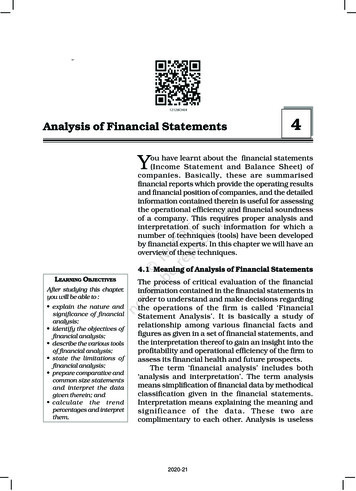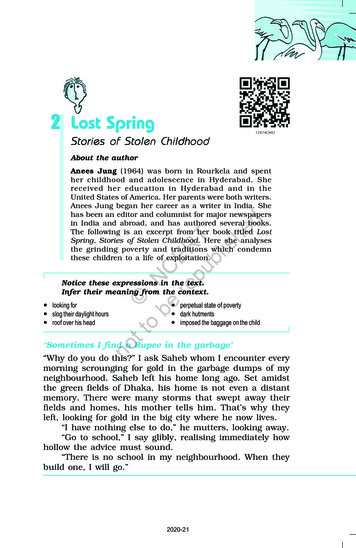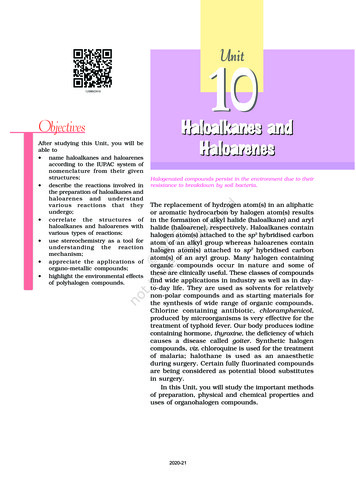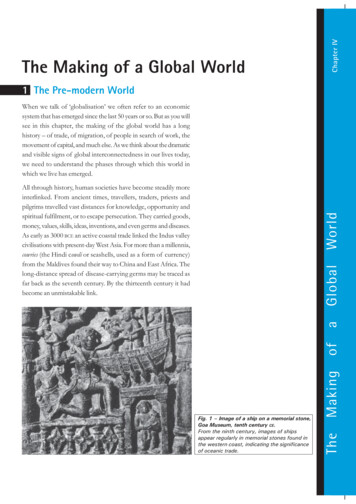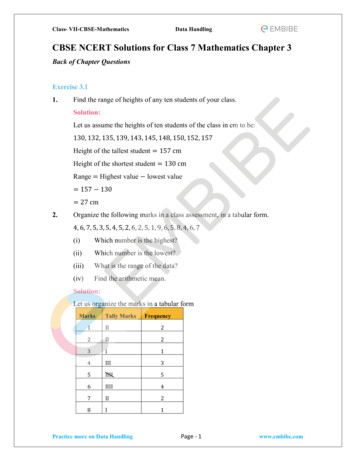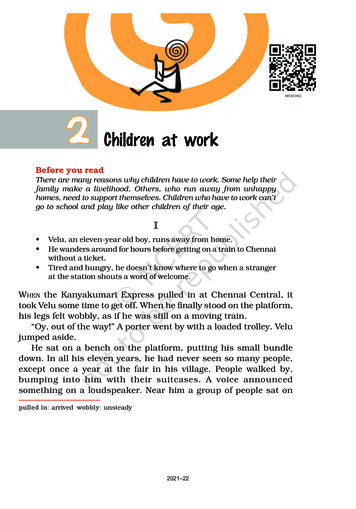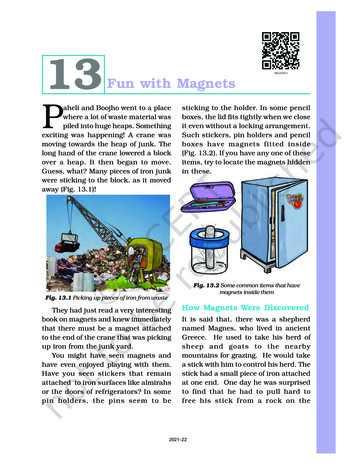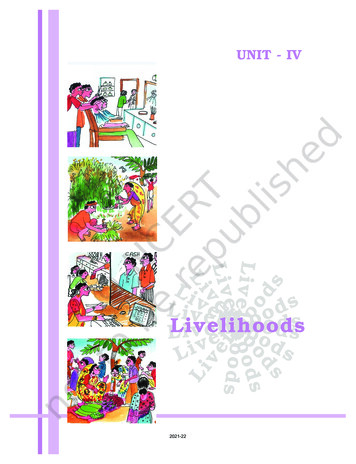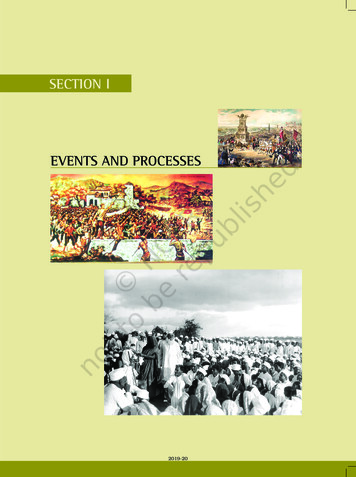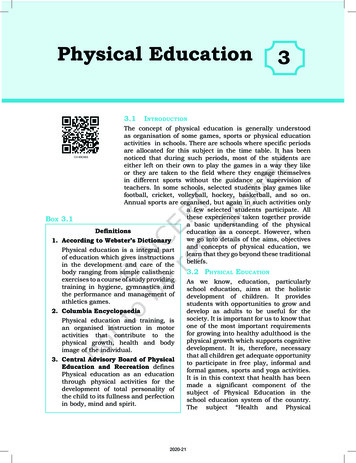
Transcription
Physical Education3.13IntroductionThe concept of physical education is generally understoodas organisation of some games, sports or physical educationactivities in schools. There are schools where specific periodsare allocated for this subject in the time table. It has beennoticed that during such periods, most of the students areeither left on their own to play the games in a way they likeor they are taken to the field where they engage themselvesin different sports without the guidance or supervision ofteachers. In some schools, selected students play games likefootball, cricket, volleyball, hockey, basketball, and so on.Annual sports are organised, but again in such activities onlya few selected students participate. Allthese experiences taken together provideBox 3.1a basic understanding of the physicalDefinitionseducation as a concept. However, whenwe go into details of the aims, objectives1. According to Webster’s Dictionaryand concepts of physical education, wePhysical education is a integral partlearn that they go beyond these traditionalof education which gives instructionsbeliefs.in the development and care of thebody ranging from simple calisthenic3.2 Physical Educationexercises to a course of study providingAs we know, education, particularlytraining in hygiene, gymnastics andschool education, aims at the holisticthe performance and management ofdevelopment of children. It providesathletics games.students with opportunities to grow and2. Columbia EncyclopaediaPhysical education and training, isan organised instruction in motoractivities that contribute to thephysical growth, health and bodyimage of the individual.3. Central Advisory Board of PhysicalEducation and Recreation definesPhysical education as an educationthrough physical activities for thedevelopment of total personality ofthe child to its fullness and perfectionin body, mind and spirit.2020-21develop as adults to be useful for thesociety. It is important for us to know thatone of the most important requirementsfor growing into healthy adulthood is thephysical growth which supports cognitivedevelopment. It is, therefore, necessarythat all children get adequate opportunityto participate in free play, informal andformal games, sports and yoga activities.It is in this context that health has beenmade a significant component of thesubject of Physical Education in theschool education system of the country.The subject “Health and Physical
Physical Education31Education” adopts a holistic definition of health within whichphysical education and yoga contribute to the physical, social,emotional and mental development of a child.In view of the above, the meaning of physical educationbecomes a little different from what is commonly understood.Physical education comprises holistic education for thedevelopment of personality of the child to its fullest andperfection in body, mind and spirit through engaging in regularphysical activities. Physical education through the medium ofphysical activities helps individuals to attain and maintainphysical fitness. It contributes to physical efficiency, mentalalertness and the development of qualities like perseverance,team spirit, leadership and obedience to rules. It developspersonal and social skills among the learners and makes apositive impact on their physical, social, emotional and mentaldevelopment. It also contributes to the total health of learnersand the community. Physical education thus, can be definedas a subject that is not only focused on physical fitness but isalso concerned with development of a number of skills, abilitiesand attitudes for leading a healthy lifestyle. It inculcates valueslike cooperation, respect to others, loyalty, self-confidence,winning with grace and losing with hope.3.3 ObjectivesofPhysical EducationAs discussed above, by now it may be clear to you that theaim of physical education is not only physical developmentbut also to equip learners with knowledge, skills, capacities,values, and the enthusiasm to maintain and carry on a healthylifestyle. It promotes physical fitness, develops motor skillsand the understanding of rules, concepts and strategies ofplaying games and sports. Students learn to either work aspart of a team, or as individuals in a wide variety of competitiveactivities. The main objectives of physical education are to: develop motor abilities like strength, speed, endurance,coordination, flexibility, agility and balance, as they areimportant aspects for good performance in differentgames and sports. develop techniques and tactics involved in organisedphysical activities, games and sports. acquire knowledge about human body as its functioningis influenced by physical activities. understand the process of growth and developmentas participation in physical activities has positiverelationship with it. develop socio-psychological aspects like control ofemotions, balanced behaviour, development of leadershipand followership qualities and team spirit throughparticipation in games and sports.2020-21Chapter-3 Physical Education.indd 3108-11-2016 11:08:01 AM
32Health and Physical Education — Class IX develop positive health related fitness habits whichcan be practised lifelong so as to prevent degenerativediseases.Activity 3.11. Find out the following facts about your school and prepare a write-up. Periods allocated for physical education in your school? What do students do during physical education periods? How many studentsof a class actually participate in activities during such periods? What type of knowledge is provided by the teachers about the concerned gamesand sports related skills? What do the students do during these classes when they are left free?2. Compare your write-up with the above objectives.3. What will you do, if some of the objectives are not covered?3.4 ScopeofPhysical EducationPhysical education has evolved as a multi-disciplinary subjectover time and its scope is not confined to physical fitness andknowing the rules of games and sports. It includes many topicswhich belong to other subjects like science, biology, genetics,psychology and sociology. It is possible that all the contentsthat constitute the scope of physical education may not find aplace in the syllabus meant for school education. However, itcontains all the content areas as stated below.3.4.1 Games and Sports as a Cultural HeritageThe games and sport activities that you play today have astrong linkage to our culture. Sport activities which dominateany region is embedded in the cultural milieu. Some of thesports that reflect the culture of a region of our country areKho-Kho, Kabbadi, Archery, Lezim, Wrestling and so on. Ourancestors survived on hunting with the use of throwingBox 3.2stones as well as bow and arrows, running, jumping etc.Physical educationwere used for survival and recreation. Later when manconsists of:became more civilised, it took the shape of competitivesports like athletics, wrestling, archery and so on. So, we games and sports as acan see a strong bonding of our culture in the presentcultural heritageevolution of games and sports. mechanical aspects inphysical education3.4.2 Mechanical Aspects in Physical Education biological contentsPhysical education takes into consideration the health education andmechanical aspects of various physical activitieswellness contentsbeing performed. You are aware that the concepts psycho-social contentregarding laws of motion, lever, force and its generation, talent identification andmaintenance of equilibrium, centre of gravity and itstraining contents.impact on movements, law of acceleration, speed and2020-21Chapter-3 Physical Education.indd 3208-11-2016 11:08:01 AM
Physical Education33its development form important content areas of physicaleducation. You will also study these aspects in your sciencetextbook.3.4.3 Biological Contents in Physical EducationThe contents drawn from the biological sciences take intoconsideration the areas of heredity and environment, growthand development, organs and systems, understanding of jointsclassification, and possible movements around these joints.In addition, muscles and their properties, effect of exerciseon various systems of the body (like circulatory, respiratory,muscular, digestive and skeletal systems) are also linked tophysical activities.3.4.4 Health Education and Wellness Contents in PhysicalEducationPhysical education includes contents related to the areaof health education through understanding the concept ofhygiene, knowledge about various communicable and noncommunicable diseases, problems relating to health and theirprevention, proper nutrition and balanced diet. Communityhealth, school health service programme, assessment of healthstatus, prevention, safety and first aid for common injuries arealso included in the scope of physical education.3.4.5 Psycho-social Content of Physical EducationPsycho-social aspect of physical education extends to thestudy of areas regarding individual differences, personalitydevelopment, learning of various skills, motivation and itstechniques, anxiety management, ethical and social values,group dynamics, cooperation, cohesiveness and learning. Italso focuses on emotional development, relationships withpeer/parents and others, self concept and self esteem.3.4.6 Talent IdentificationPhysical EducationandTrainingContentinPhysical education includes contents with regard to talentidentification, development of components in relation tospecific sport, understanding of various types of activitieslike aerobic, anaerobic, rhythmic and calisthenics. Trainingprogrammes, learning and perfection of various movements,sport skills, techniques and tactical patterns, warming up,load adaptation, recovery and cooling down are also a part ofphysical education.3.5 Teaching-Learning ApproachWe have, so far, discussed the importance of physical educationas a subject area in the school curriculum. It is an integralpart of Health and Physical Education which is prescribed as2020-21Chapter-3 Physical Education.indd 3308-11-2016 11:08:01 AM
34Health and Physical Education — Class IXa compulsory subject at the Primary (Classes/Grades I-V),Upper Primary (Classes/Grades VI-VIII) and Secondary stages(Classes/Grades IX-X) and as an optional subject at HigherSecondary stage (Classes/Grades XI-XII). But as you may beexperiencing in actual practices, this subject has not beentreated at par with other core subjects. It is not transactedsatisfactorily in majority of schools. And wherever it istransacted, either some knowledge about games and sports isimparted or only a selected group of students are engaged ingames and sports as extra-curricular activities.Arguments like lack of the needed infrastructure andequipments, absence of trained teachers and paucity of timein schools are given as reasons for indifferent transaction ofphysical education. In fact most significant reason is the lackof appreciation of the relevance of this area for the holisticdevelopment of children by school authorities, teachers andparents.3.5.1 Methodology of Teaching-learningIt is generally believed that the methodology of teachinglearning is the concern of teachers only. Learners have littleor nothing to do with it. But this is not true. The teachinglearning methods are concerns of learners as well. Knowingand understanding that how different subjects are taughtare important for the learners of all subjects, but it has morerelevance for the learners of physical education. When wetalk about you as learners of physical education,Box 3.3we mean that you have actually participated in thesubject area, rather than merely studied it. It needs a(i) Why do you feel that it issuitable learning environment and a positive will forimportant for studentsparticipation. As you now know, physical educationto know how physicaldoes not mean organisation of a few sports and gameseducation activities areactivities, involving only a selected number of students,organised in school?and that too occasionally. The following points are(ii) Should the focus ofsignificant for the appreciation of this subject andphysicaleducationthe need for adopting appropriate teaching – learningbe only on selectedmethodology:students or for all? You Physical education is necessary to ensurecan also discuss withparticipation of all children in free play, informal andyour classmates.formal games and sports activities. All students must(iii) Seema is a differentlybe involved in health and physical education activities.abled girl and is onThose who choose to excel in games and sports needa wheelchair in theto be provided adequate opportunity.playground. What will Involvement of all learners means that even thoseyou do to involve herstudents need to be involved, who are at the risk ofin the game you aremarginalisation, for instance, who are differently abled.playing?Such involvement will empower them to overcome the2020-21Chapter-3 Physical Education.indd 3408-11-2016 11:08:01 AM
Physical Education35sense of helplessness, inferiority and stigma. Differencesbetween students must be viewed as resource forsupporting learning rather than as a problem. Inclusionin education is one of the components of inclusion insociety.3.5.2 Physical Education Cards (PEC) MethodologyActivity 3.2You must haveobserved somestudents notparticipating inphysical educationactivities includingsports in yourschool. Discusswith them and yourpeers how to ensuretheir participation inphysical activities,individual andsports.Various methodologies are being employed and efforts are onto develop innovative teaching-learning methodologies, onesuch methodology known as PEC-India Methodology has beendeveloped. It is the outcome of a joint initiative of the BritishCouncil and the Ministry of Human Resource Development,Government of India. Other international organisations, UnitedNations International Children Emergency Fund (UNICEF)and U.K. Sports were also involved. To begi
a basic understanding of the physical education as a concept. However, when we go into details of the aims, objectives and concepts of physical education, we learn that they go beyond these traditional beliefs. 3.2 PhysIcal EducatIon As we know, education, particularly school education, aims at the holistic development of children. It provides students with opportunities to grow and develop as .
